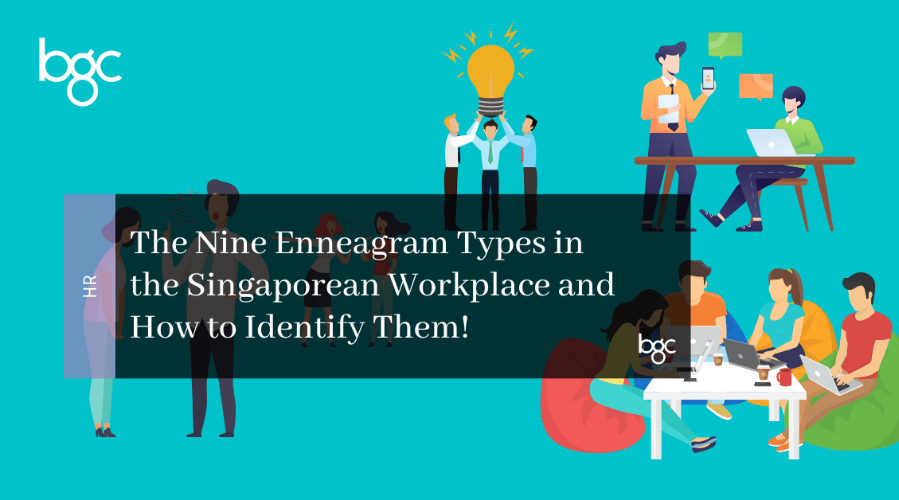There are many different ways for hiring managers and recruiters to utilise personality tests. We like to describe personality tests as an analog HR system often used by employers to find candidates with traits that are best suited for different roles. In this article, we will be focusing on the Enneagram type personality test.
What is the Enneagram test?
Much like the Myers-Briggs personality test we’ve written about before. The Enneagram test is a psychological system that describes the different patterns in how individuals manage their emotions and the world around them. According to the Enneagram system, there are nine different personality types. These personality types are then further categorized into three groups: the head (Thinking centre), the heart (Feeling centre) and the gut triad (Instinctive centre). Learn more about the three triads or centre of intelligence in this blogpost by Truity. Or take the free Enneagram Type Test by Crystal Knows here!
Now that you understand the basics of the Enneagram test, it is time to learn about the different Enneagram types and how recruiters can type an individual. We will be giving tips on how recruiters and hiring managers can type their employees and interview candidates based on both their verbal and non-verbal cues. Ready to find out more? Let’s dive in!
Enneagram Type One: The Reformer

Type ones are individuals motivated by strong principles and a desire to reinvent the world for good. These are perfectionists and idealists who envision a world that is ethical and fair for most people. Their main mission is to continue working to improve themselves, other people and the world around them. Ones bring integrity and commitment to their work. They’re responsible and conscientious, often having an eye for detail. At the workplace, Ones are often willing to go the extra mile and often set standards for their team.
Type One at the workplace
Type Ones struggle with perfectionism. It is challenging for these types to not expect too much from both themselves and the people they work with. Ones get stressed at work when they put in more effort than others. They do this to ensure that the standards at work are up to theirs. If you are working with a Type One, try to bond with them to allow these rigid individuals to have a little fun and relax!
Learn more about the Enneagram Type One personality here.
Enneagram Type Two: The Helper

Type Twos are individuals motivated by their desire to build loving and nurturing connections with the people around them. Type Two’s can be identified by their empathy and emotional intelligence. Due to their giving nature, Type Two’s tend to overcommit without checking in with their time or energy. Individuals with this Enneagram type are motivated by their need to express and feel appreciated.
Type Two at the workplace
Type Two’s are so giving that they tend to focus on meeting their colleague’s needs. This can cause them to forget their own needs or even work at times. Type Two’s are often gifted at cultivating relationships with clients and colleagues. In other words, they’re people pleasers, which can make them great for client and customer-facing roles. If you are working with a Type Two, try to inspire them to cultivate their own interests and projects that don’t directly involve working with other people. This might provide them with a break, allowing Two’s to focus on themselves and their own interests.
Learn more about the Enneagram Type Two personality here.
Enneagram Type Three: The Achiever

Type Three’s can often be identified by their charming and ambitious demeanour. These individuals can be status-conscious and are motivated by success and recognition. Three’s are dedicated and efficient. They often focus on achieving goals and are motivated both by their tasks and recognition. Their key motivation is to achieve in order to gain admiration and attention from others.
Type Three at the workplace
These individuals have a knack for assessing the desires of other people and making the needed changes. Enneagram practitioners often describe Threes as the ideal type for marketing and presentation based positions. At the workplace, Three’s might be resistant to delegating certain tasks to their colleagues as they believe that they will be able to do a better job than others. Because of this, Three’s have the tendency to burnout. If you’re working with a Type Three, find ways to remind them to take frequent breaks and delegate tasks to others.
Learn more about the Enneagram Type Three personality here.
Enneagram Type Four: The Creative
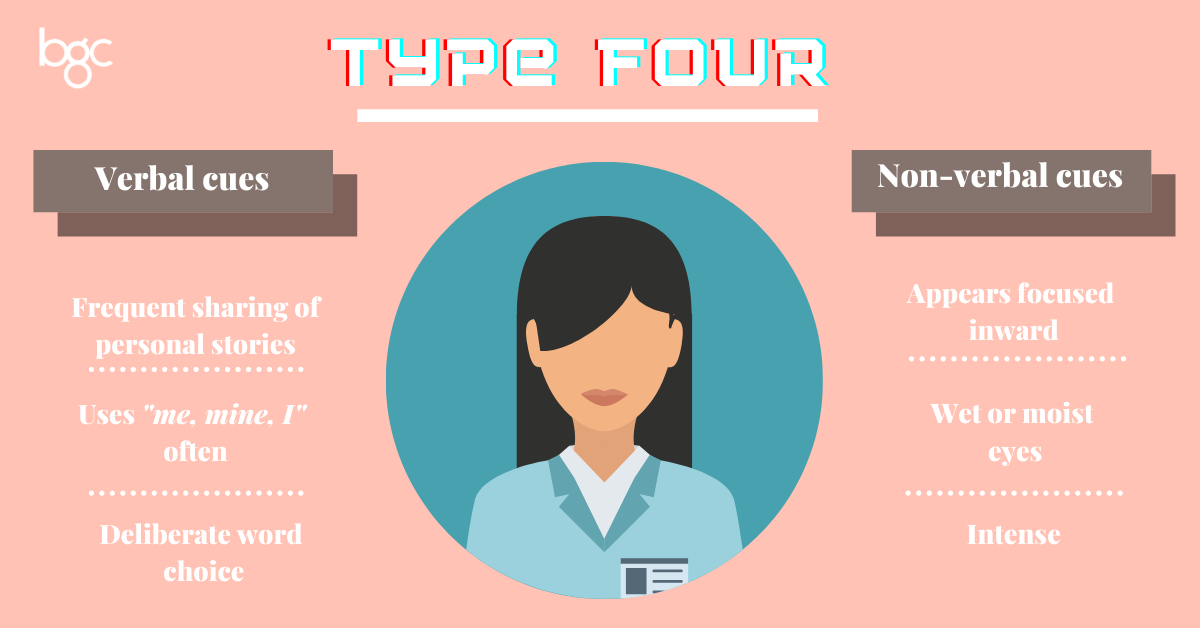
Type Four’s can be described as sensitive, creative, and dramatic. Four’s want to create unique products, ideas or designs that are often drawn from their imaginations. These individuals are often attuned to both the emotions of their clients and colleagues, often empathizing with them. The key motivation for Four’s is to express themselves and their individuality and maintain harmony.
Type Four at the workplace
Despite bringing emotional intelligence to the workplace, the daily work grind can be a struggle for Type Fours. Additionally, these individuals often bring both their creativity and sensitivity to the workplace. If you’re working with Four’s, regularly checking in with these colleagues can help them stay on track with their deadlines and keep them accountable.
Learn more about the Enneagram Type Four personality here.
Enneagram Type Five: The Investigator

Type Five’s are highly cerebral individuals. As such, they often appear emotionally detached and self-contained. Five’s want to absorb knowledge in areas that they perceive to be interesting, important, and intriguing. Five’s are motivated by their need to possess infinite knowledge as well as understand the world around them.
Type Five at the workplace
Despite having masterful knowledge, Type Five’s are not gifted with the art of socializing. These individuals get overwhelmed very easily by what they perceive as demands from other people. Under stress, Five’s tend to withdraw and retreat from the interaction. If you’re working with a Type Five, remember to include them in your conversations. Connections help Five’s feel less isolated and as such are likely to make more valuable and creative projects.
Learn more about the Enneagram Type Five personality here.
Enneagram Type Six: The Loyalist
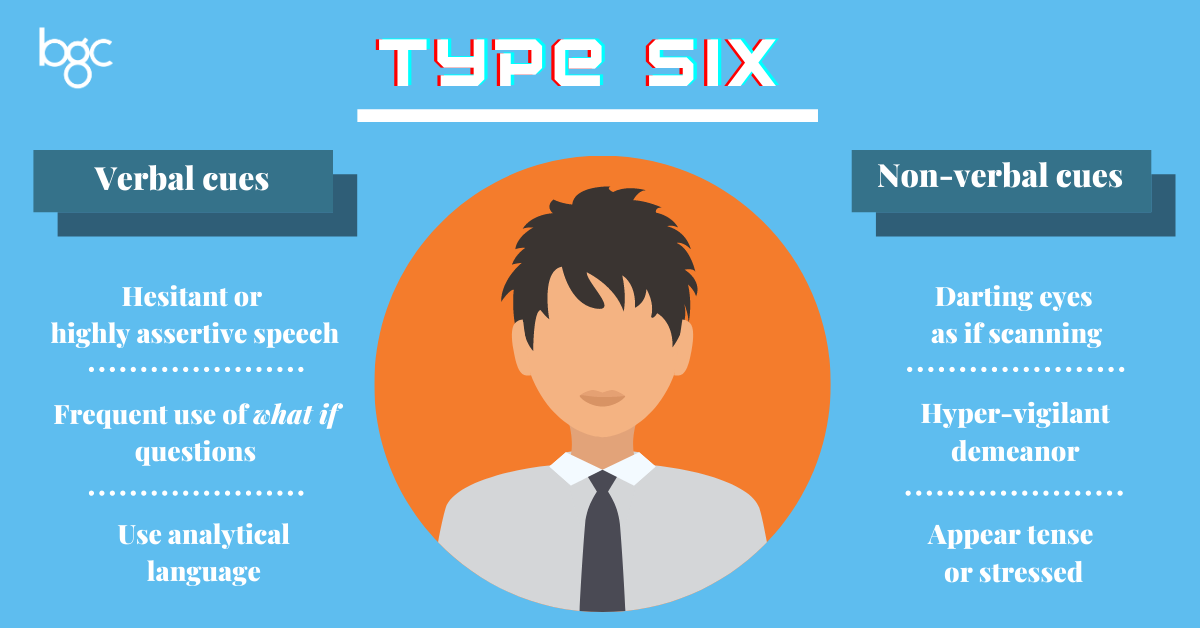
Hard-working and responsible, Type Six are individuals motivated by their need to feel supported by the people around them. Sixes are often collaborative and once they’ve identified their interests, they’ll put in the hard work to see this through. Additionally, Sixes often assume the role of the troubleshooters of the team.
Type Six at the workplace
At the workplace, Sixes are often courageous advocates for both the individuals and causes they care about. However, this is an Enneagram Type that often worries about the negative outcomes. Because of this, they can get sidetracked from the main job that needs to be completed. If you’re working with a Type Six, let these individuals show their knowledge and interests. This helps them alleviate their anxiety head-on.
Learn more about the Enneagram Type Six personality here.
Enneagram Type Seven: The Enthusiast
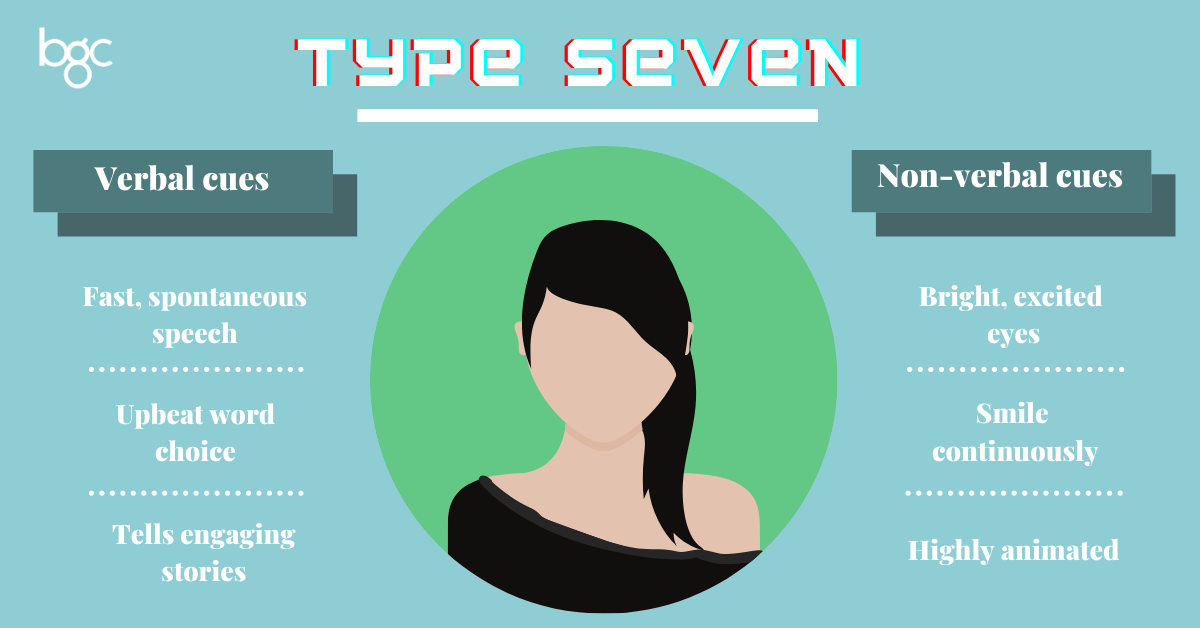
You’ll know when you’re around an Enneagram Type Seven. These individuals want to experience everything that is new, stimulating, and exciting. Sevens often present as extroverted and playful. People with this Enneagram type are motivated by the need to maintain their freedom and happiness. At the workplace, clients and colleagues love being surrounded by their sense of fun and creativity.
Type Seven at the workplace
Type Sevens are motivated by new possibilities. It is easy to capture their attention. As such, Sevens can be very distracted at the workplace. If you work with a Type Seven, try to cultivate their focus by helping them set schedules for themselves. But at the same time, allow them to have space to cultivate their other ideas.
Learn more about the Enneagram Type Seven personality here.
Enneagram Type Eight: The Challenger
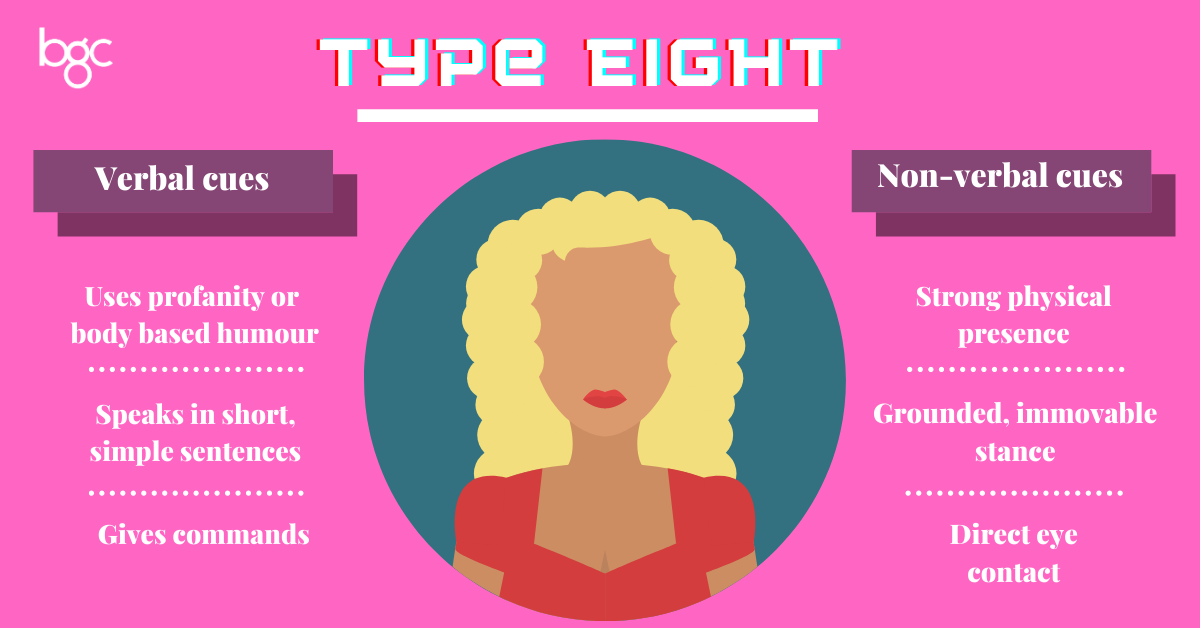
Type Eight often present themselves as commanding and risk-takers. Individuals with this Enneagram type often end up in leadership positions. Eights are motivated by their need to be self-reliant and to dominate and control their environment.
Type Eight at the workplace
As they’re often found in leadership positions, Type Eights can come off as being intimidating. When stressed out, these individuals can react rather aggressively. This can strain their working relationships with their colleagues. If you work with a Type Eight, teach them to read emotional intelligence. This can help Eights tap into their gentle and more emotional side.
Learn more about the Enneagram Type Eight personality here.
Enneagram Type Nine: The Peacemaker

Type Nines are often described as creative, optimistic and supportive. These individuals seek harmony and often desire peace when it comes to the workplace. Nines are often able to see both sides of the coin. Because of this, they’re often able to connect with other people easily.
Type Nine at the workplace
At the workplace, Nines aim to create a relaxing work environment, where everyone can feel included and connected. Type Nines are patient personalities and can often fly under the radar at the workplace. If you work with a Type Nine, allow them to be their best selves by encouraging them to work without procrastinating. Let them take the lead once in a while. You might be surprised by this usually meek personality.
Learn more about the Enneagram Type Nine personality here.
Love our personality type themed articles? Visit the BGC Group blog for similar articles! What’s your Enneagram Type? Share them with us in the comments section below!
Read More: The Best Career Fields For Introverts
